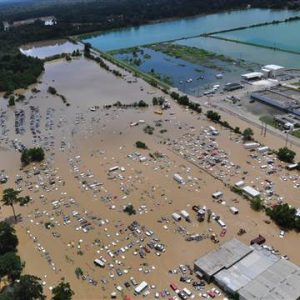AIR Worldwide, the global catastrophe and insurance risk modelling firm, has estimated that “industry ground-up” insurable losses, so including exposures eligible for insurance coverage (regardless of whether they are actually insured).
 As such this isn’t an estimate of the what the insurance and reinsurance industry will pay in claims for the recent devastating Louisiana flooding, rather of what they could have paid had flood insurance uptake been higher in the state.
As such this isn’t an estimate of the what the insurance and reinsurance industry will pay in claims for the recent devastating Louisiana flooding, rather of what they could have paid had flood insurance uptake been higher in the state.
AIR’s estimate of insurable losses does not apply deductibles or limits to exposures that could be eligible for insurance. Hence it’s a pure look at the potential magnitude of loss such a flooding event could have caused.
AIR’s estimate puts the potential insurable loss from the flooding in Louisiana caused by excessive rainfall during August 2016 at somewhere between $8.5 billion and $11 billion.
“Extreme rainfall-induced flash flooding and river flooding on the floodplain have wreaked havoc in Louisiana, breaking records and damaging property throughout many parishes,” commented Dr. Boyko Dodov, vice president and director of flood modeling at AIR Worldwide. “Beginning around August 10, 2016, rainfall continued almost perpetually for approximately seven days, resulting in accumulations of around 7.1 trillion gallons in Baton Rouge and the surrounding suburbs, according to reports, reaching upwards of 30 inches in some areas.”
August 2016 was the wettest month on record for Baton Rouge, Louisiana since 1907. The NOAA said that research shows such a rainfall event could occur at least 40% more often than it was in our pre-industrial past, AIR said
AIR explains its estimate methodology:
AIR’s loss estimates explicitly capture residential, commercial, and automobile losses from inland flood both on and off the floodplain based on 100 simulated event scenarios that reflect uncertainty in precipitation observations and modeled levee failures. These loss estimates were derived based on AIR’s high-resolution Industry Exposure Database (IED) for the United States and damage ratios estimated from reported flood inundation. The U.S. IED vintage is December 2015.
The range in AIR’s loss estimates also reflects uncertainty in the payment of additional living expenses resulting from relocation, time spent in secondary housing, lost wages, loss of electricity, and damage to contents. Please note that total economic losses are expected to be higher than industry insurable loss estimates.
The modeled hazard intensities reflect the maximum estimated river flows and maximum excess runoff intensities during the event from August 8–19, 2016. Note that many reinsurance contracts are subject to an hours clause (typically 168 hours for flood events). Given the duration of this event, AIR expects the flood to be treated as a single occurrence in Louisiana.
AIR’s insurable loss estimates reflect:
- Insurable physical damage to property (residential, commercial), both structures and their contents, and auto
- Direct business interruption losses
The loss estimates do not reflect:
- Losses to land
- Losses to infrastructure
- Losses to CAR/EAR, Marine Hull, or Marine Cargo lines of business
- Indirect business interruption losses
- Loss adjustment expenses
- Demand surge—the increase in costs of materials, services, and labor due to increased demand following a catastrophic event. Demand surge can be applied by AIR software users who want to account for this variable.
The Louisiana flooding is estimated to have caused up to $15 billion of economic losses, with only a low billions of insurance and reinsurance industry loss, by Aon Benfield.
AIR’s estimate of insurable loss, shows that a large proportion of the economic loss could have been covered, had insurance penetration rates been higher in Louisiana.
Some reinsurance capital will pay for a portion of the losses from the floods, with some primary insurers expecting some support from their reinsurers. However the loss passed on to reinsurance capital will be much smaller than it could have been, had the amount of insurable exposures covered been higher.
While an insurable loss estimate is not perhaps as useful as an insured one, it does demonstrate the need for greater insurance penetration and coverage of flood risks as, with a greater amount of exposures covered, this could have been a really major event for the insurance, reinsurance and ILS industry.
Also read:
– Louisiana floods up to $15bn economic loss, low $bn’s insured: Aon.
– Reinsurance capital could pay for some of Louisiana flooding.
 View all of our Artemis Live video interviews and subscribe to our podcast.
View all of our Artemis Live video interviews and subscribe to our podcast.
All of our Artemis Live insurance-linked securities (ILS), catastrophe bonds and reinsurance video content and video interviews can be accessed online.
Our Artemis Live podcast can be subscribed to using the typical podcast services providers, including Apple, Google, Spotify and more.































